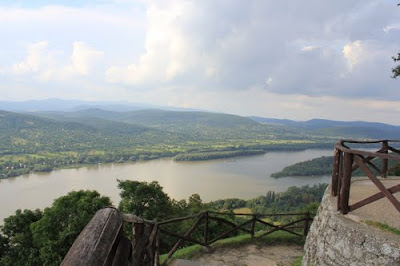Click here for the Introduction.
 |
| Visegrad Castle. Photo credit: Petroskala1 |
20 miles – Monday, September 12
This morning we walked up a steep path to visit the Visegrad
Castle. The stone structure was comprised of two sections: an inner and outer
wall fortress. In the late 1800s the building was preserved and since then it
has been under construction. One area was cordoned off. Workmen hauled gravel and stone
from an archaeological dig.
 |
| View of Danube from Visegrad Castle. Photo credit: Petroskala1 |
Despite the beautiful view of the Danube below, the castle
was a disappointment. Reparations were half in red brick, half in stone;
neither hastily patched masonry matching the original grey stone in size or
color. Inside, the displays of boars, deer, archery, and stonework were
littered in 1 Forint coins. I wondered why the money wasn’t removed and put to
good use on the castle’s reconstruction. It seemed incongruent with the
majestic site. The Danube curves in an S-shape where the castle is positioned;
a strategic place if there was any. Sadly, we left.
 |
| My man on the ferry landing. |
Andy and I hopped on a small ferry to an island, an
alternate to the main bike route. Two workers hoisted our heavy bikes inside
the boat with amazing ease. I imagined the boat takes on lots of two-wheeled
travelers during the summer. Those tourists only use rear panniers, we noticed,
and if we weren't planning on colder weather later in our trip, we’d certainly
get by with less.
 |
| Visegrad Castle's prominent perch. Photo credit: WallpapersTravel.com |
The island ride was pretty and quiet, but too short. In
Szentendre we pedaled on a separate path and followed it into Budapest. In
places the trail follows the riverbank. C-1 racing canoes and kayaks bullet by
us. It was tempting to keep on riding, but reluctantly we steered away from the
water to locate a campground.
At 5 o’clock we purchased dinner supplies from an outdoor
produce market. It’s the best place for fruits and vegetables, but they also
sell eggs and pasta. And because other stores had closed, we were thrilled to
have a selection. Potatoes, red and yellow peppers, 6 eggs, onion, cucumber,
plums and nectarines are a bargain for $2.35. Our money buys quite a lot in
Hungary.
Other things of note: Fishermen tote collapsible poles and
net in a backpack, while riding a bike or moped. It’s common to find them
clothed in army green uniforms, some with knee high boots. Just the other day a
man passed us toting a net full of fish. Mainly, though, they hang out on the
riverbank. Lots of guys. We wonder what they do for work.
 |
| Woman harvesting on Szentendre Island. Photo credit: Szakmary Katalin |
Like the Czech Republic, harvesting in small villages is
done by hand. Lately, we ride by sweet smelling clover fields. A man scythes an
area, then a woman rakes and gathers bunches, throwing them onto a cart.
 |
| Andy's drawing of the rototiller-type cart. |
Farmers often pass us in a small, loud motorized wagon. For
several days we knew something was familiar about the contraption, but Andy’s figured
it out. It is a rototiller with an adapter that enables it to be used as a
drive around cart. The tines have been removed, retrofitted to a wooden box on wheels.
We imagine the tiller is reattached in the spring for turning the earth.
Looks like and intersting place.
ReplyDelete